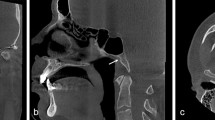Abstract
Purpose
This study determined the prevalence of fossa navicularis magna (FNM), canalis basilaris medianus (CBM), and craniopharyngeal canal (CPC), the size of FNMs, and types of CBM using 3D computed tomography (CT) images.
Methods
A total of 1059 3D images [649 cone beam computed tomography (CBCT) and 410 CT] were evaluated in this study. The prevalence of FNM, CBM, and CPC, length, width, and depth of FNM, and type of CBM were assessed.
Results
Overall, FNM was identified in 7.6%, CPC in 0.3%, and CBM in 2.5% of the study group. Type 2 (0.1%) and Type 6 (0.1%) are the least common CBM types. There was no significant difference between genders for depth and width measurements (p > 0.05), however, the length of FNM was significantly higher in males than females in CBCT images (p = 0.02).
Conclusion
FNM, CBM, and CPC are rare anatomical variants of clivus. However, they can facilitate spread of infection to the skull base or vice-versa. These types of anatomical variations should be known by radiologists to avoid unnecessary diagnosis and treatment procedures and to distinguish anatomic variations from pathological conditions.




Similar content being viewed by others
References
Abele TA, Salzman KL, Harnsberger HR, Glastonbury CM (2014) Craniopharyngeal canal and its spectrum of pathology. Am J Neuroradiol 35:772–777
Ahmad M, Jenny J, Downie M (2012) Application of cone beam computed tomography in oral and maxillofacial surgery. Aust Dent J 57(Suppl 1):82–94
Akyel NG, Alimli AG, Demirkan TH, Sivri M (2018) Persistent craniopharyngeal canal, bilateral microphthalmia with colobomatous cysts, ectopic adenohypophysis with Rathke cleft cyst, and ectopic neurohypophysis: case report and review of the literature. Childs Nerv Syst 34:1407–1410
Arey LB (1950) The craniopharyngeal canal reviewed and reinterpreted. Anat Rec 106:1–16
Beltramello A, Puppini G, El-Dalati G, Girelli M, Cerini R, Sbarbati A et al (1998) fossa navicularis magna. Am J Neuroradiol 19:1796–1798
Cankal F, Ugur HC, Tekdemir I, Elhan A, Karahan T, Sevim A (2004) Fossa navicularis: anatomic variation at the skull base. Clin Anat 17:118–122
Cho KH, Chang H, Yamamoto M, Abe H, Rodriguez-Vazquez JF, Murakami G et al (2013) Rathke’s pouch remnant and its regression process in the prenatal period. Childs Nerv Syst 29:761–769
Currarino G (1988) Canalis basilaris medianus and related defects of the basiocciput. Am J Neuroradiol 9:208–211
Ersan N (2017) Prevalence and morphometric features of fossa navicularis on cone beam computed tomography in Turkish population. Folia Morphol (Warsz) 76:715–719
Hemphill M, Freeman JM, Martinez CR, Nager GT, Long DM, Crumrine P (1982) A new, treatable source of recurrent meningitis: basioccipital meningocele. Pediatrics 70:941–943
Jacquemin C, Bosley TM, al Saleh M, Mullaney P (2000) Canalis basilaris medianus: MRI. Neuroradiology 42:121–123
Kasim N, Choudhri A, Alemzadeh R (2018) Craniopharyngeal canal, morning glory disc anomaly and hypopituitarism: what do they have in common? Oxf Med Case Rep 2018:018
Kaushik C, Ramakrishnaiah R, Angtuaco EJ (2010) Ectopic pituitary adenoma in persistent craniopharyngeal canal: case report and literature review. J Comput Assist Tomogr 34:612–614
Khairy S, Almubarak AO, Aloraidi A, Alahmadi KOA (2017) Canalis basalis medianus with cerebrospinal fluid leak: rare presentation and literature review. Br J Neurosurg. https://doi.org/10.1080/02688697.2017.1346173
Kizilkilic O, Yalcin O, Yildirim T, Sener L, Parmaksiz G, Erdogan B (2005) Hypothalamic hamartoma associated with a craniopharyngeal canal. Am J Neuroradiol 26:65–67
Lohman BD, Sarikaya B, McKinney AM, Hadi M (2011) Not the typical Tornwaldt’s cyst this time? A nasopharyngeal cyst associated with canalis basilaris medianus. Br J Radiol 84:169–171
Martinez CR, Hemphill JM, Hodges FJ III, Gayler BW, Nager GT, Long DM et al (1981) Basioccipital meningocele. Am J Neuroradiol 2:100–102
Morabito R, Longo M, Rossi A, Nozza P, Granata F (2013) Pharyngeal enterogenous cyst associated with canalis basilaris medianus in a newborn. Pediatr Radiol 43:512–515
Neelakantan A, Rana AK (2014) Benign and malignant diseases of the clivus. Clin Radiol 69:1295–1303
Pinilla-Arias D, Hinojosa J, Esparza J, Munoz A (2009) Recurrent meningitis and persistence of craniopharyngeal canal: case report. Neurocirugia (Astur) 20:50–53
Prabhu SP, Zinkus T, Cheng AG, Rahbar R (2009) Clival osteomyelitis resulting from spread of infection through the fossa navicularis magna in a child. Pediatr Radiol 39:995–998
Ray B, Kalthur S, Kumar B, Bhat M, D’souza A, Gulati H et al (2014) Morphological variations in the basioccipital region of the South Indian skull. Nepal J Med Sci 3:124–128
Rizzo A (1901) Canale cranio faringeo, fossetta faringea, interparietali e pre-interparietali nel cranio umano. Mon Zool Ital 12:241–252
Romiti G (1890) La fossetta faringea nell’osso occipitale dell’uomo. Atti Soc Toscana Sci Nat 1:11
Rossi U (1891) Il canale cranio-faringeo e la fossetta faringea. Monitore Zoologico Italiano 2:117
Segal N, Atamne E, Shelef I, Zamir S, Landau D (2013) Intracranial infection caused by spreading through the fossa naviclaris magna—a case report and review of the literature. Int J Pediatr Otorhinolaryngol 77:1919–1921
Syed AZ, Mupparapu M (2016) Fossa navicularis magna detection on cone-beam computed tomography. Imaging Sci Dent 46:47–51
Syed AZ, Zahedpasha S, Rathore SA, Mupparapu M (2016) Evaluation of canalis basilaris medianus using cone-beam computed tomography. Imaging Sci Dent 46:141–144
Author information
Authors and Affiliations
Contributions
Protocol Development: KO. Data Collection-Analysis: SB, KO. Manuscript Writing: DGB, SB. Manuscript Editing: KO.
Corresponding author
Ethics declarations
Conflict of interest
The authors declare that there is no conflict of interest.
Additional information
Publisher’s Note
Springer Nature remains neutral with regard to jurisdictional claims in published maps and institutional affiliations.
Rights and permissions
About this article
Cite this article
Bayrak, S., Göller Bulut, D. & Orhan, K. Prevalence of anatomical variants in the clivus: fossa navicularis magna, canalis basilaris medianus, and craniopharyngeal canal. Surg Radiol Anat 41, 477–483 (2019). https://doi.org/10.1007/s00276-019-02200-3
Received:
Accepted:
Published:
Issue Date:
DOI: https://doi.org/10.1007/s00276-019-02200-3




